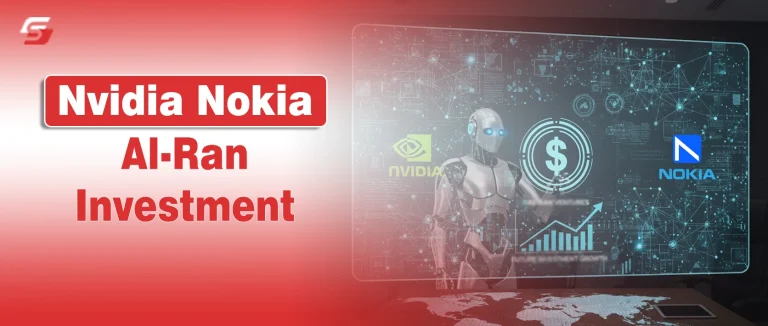With a $1 billion investment, Nvidia powers Nokia’s push into AI-RAN technology, reshaping how 5G evolves into intelligent, self-optimizing 6G systems.
On the surface, it looks like a bold financial partnership. Beneath it, however, lies a deeper technological shift: the fusion of artificial intelligence and radio access networks (AI-RAN).
This collaboration signals more than corporate alignment; it hints at the architecture of the next generation of connectivity, where AI-driven telecom systems will think, learn, and adapt in real time.
As the world edges toward 6G innovation, questions arise, is this the moment AI truly takes control of global communication infrastructure, and can Nvidia and Nokia redefine how networks evolve from hardware to intelligence?
Understanding AI-RAN and Its Role in 5G–6G Evolution
AI-RAN, or Artificial Intelligence–Driven Radio Access Network, represents the next phase in telecom network architecture where artificial intelligence (AI) is embedded into RAN functions to enhance automation, resource management, and energy efficiency.
The technology integrates machine learning models, cloud-native infrastructure, and edge computing to enable real-time decision-making in mobile networks. As telecom operators prepare for 6G deployment, AI-RAN serves as the foundation that connects AI algorithms, radio hardware, and software-defined network layers for intelligent, self-optimizing connectivity.
What is AI-RAN and How It Integrates Artificial Intelligence into Radio Networks
AI-RAN refers to a radio access network architecture that uses artificial intelligence to optimize communication between base stations, user devices, and the core network.
AI-RAN integration occurs through three main components:
- AI-based control algorithms that adjust radio frequency and signal parameters dynamically.
- Cloud-native RAN software deployed on virtualized servers, allowing scalability and distributed intelligence.
- Edge AI processing units that analyze network data locally to reduce latency and enhance responsiveness.
Nvidia contributes through GPU-accelerated platforms like Aerial SDK and CUDA frameworks, while Nokia embeds AI orchestration tools in its AirScale RAN systems. Together, these systems create a self-learning network capable of predicting traffic demand, optimizing signal strength, and reducing human intervention.
How AI-RAN Improves Network Performance, Latency, and Energy Efficiency
AI-RAN improves network performance by applying real-time analytics to traffic data and spectrum usage. The system identifies congestion, predicts user mobility, and reallocates bandwidth based on dynamic demand.
| Attribute | AI-RAN Impact |
| Latency | Reduces delay through localized AI inference at edge nodes. |
| Throughput | Increases data capacity by optimizing channel utilization. |
| Energy Efficiency | Minimizes power use via AI-driven sleep modes for radio units. |
| Reliability | Enhances connection stability using predictive fault detection. |
Why AI-RAN Is Essential for the Evolution from 5G to 6G Technology
AI-RAN is essential to the 5G-to-6G transition because it transforms static network management into self-evolving intelligence. In 5G, RAN optimization relies on pre-set configurations; in 6G, AI-RAN enables context-aware communication, where the network adapts autonomously to traffic patterns, environmental changes, and service types (e.g., autonomous vehicles, smart cities, or IoT clusters).
Key drivers making AI-RAN indispensable include:
- Scalability: Supports billions of interconnected devices expected in 6G ecosystems.
- Autonomy: Uses continuous AI learning loops for zero-touch network operation.
- Resilience: Predicts and mitigates faults before service degradation occurs.
- Resource Efficiency: Allocates radio resources dynamically for minimal waste.
This shift marks a transition from reactive networks to proactive ecosystems, where AI determines performance in real time, reducing both operational cost and human error.
The Link Between Cloud-Native RAN, Machine Learning, and Telecom Automation
The relationship between Cloud-Native RAN, machine learning, and telecom automation forms the technological backbone of AI-RAN. Cloud-Native RAN (C-RAN) virtualizes network functions, allowing operators to deploy AI workloads flexibly across distributed cloud and edge environments. Machine learning models embedded in this infrastructure enable automated network configuration, traffic forecasting, and fault detection without manual input.
The synergy works as follows:
- Cloud-Native Infrastructure provides scalable compute environments.
- Machine Learning Algorithms interpret real-time network metrics.
- Automation Systems execute decisions like load balancing or handover optimization.
This integration creates an adaptive and intelligent network fabric, where AI, cloud computing, and automation collectively sustain ultra-fast, energy-efficient, and resilient telecom connectivity, setting the stage for fully autonomous 6G networks.
You can also read How SolidWorks Is Revolutionizing CAD Through AI to explore how machine learning is driving precision, automation, and innovation in computer-aided design.
Inside Nvidia’s $1 Billion Investment in Nokia
Nvidia’s $1 billion investment in Nokia marks a major strategic expansion of artificial intelligence into telecom infrastructure. The deal unites Nvidia’s GPU-driven computing expertise with Nokia’s network technology leadership, targeting the global shift toward AI-RAN (Artificial Intelligence Radio Access Networks).
This collaboration aims to accelerate the evolution from 5G to 6G, enhance network intelligence, and create scalable frameworks for AI-powered telecom automation. By merging Nvidia’s accelerated computing platforms with Nokia’s AirScale RAN systems, the partnership positions both companies to lead the next generation of AI-integrated mobile networks.
Overview of the Nvidia–Nokia Partnership Structure and Purpose
The Nvidia–Nokia partnership is structured as a strategic technology and financial collaboration. Nvidia’s investment provides capital infusion and technical integration, while Nokia contributes telecom infrastructure expertise and global deployment capabilities.
The purpose of the partnership includes:
- Integrating Nvidia’s AI processors and Aerial SDK into Nokia’s base station hardware.
- Enabling cloud-native RAN deployment using Nvidia’s Grace Hopper superchips for AI inference.
- Enhancing network automation and energy-efficient operations through AI-driven analytics.
- Developing AI-RAN frameworks that enable predictive, self-healing network functions.
Together, the companies aim to build a scalable AI-powered RAN ecosystem, where AI enhances network capacity, reliability, and energy performance across telecom providers.
Timeline: When and How the Investment Was Announced
The Nvidia–Nokia investment was publicly announced in October 2025, following months of strategic discussions on AI infrastructure convergence. The announcement came during Nokia’s Global Innovation Forum, where both companies outlined their joint vision for AI-RAN standardization and telecom transformation.
The timeline of key developments includes:
- Q2 2025: Initial partnership talks and R&D framework agreement.
- Q3 2025: Joint AI-lab establishment focusing on AI-RAN testbeds.
- October 2025: Formal announcement of Nvidia’s $1 billion equity investment in Nokia.
- Post-2025: Roadmap for 6G pilot networks and AI-RAN deployments in Europe and North America.
This sequence reflects a deliberate strategy, moving from research collaboration to capital partnership, aligning with global telecom modernization timelines.
Nvidia’s Strategic Motivation for Entering the Telecom Infrastructure Market
Nvidia’s motivation for investing in telecom stems from its goal to extend AI computing beyond data centers into edge and network environments. The telecom sector presents a scalable opportunity for AI workload deployment across millions of edge nodes.
Key strategic motives include:
- AI Expansion: Bringing Nvidia’s GPU acceleration to radio networks, enabling real-time AI processing closer to users.
- Market Diversification: Reducing dependency on cloud and enterprise segments by entering telecom hardware and software ecosystems.
- AI-RAN Leadership: Establishing Nvidia as a foundational player in AI-driven 6G infrastructure.
- Sustainability Goals: Supporting low-energy network design through AI-powered load balancing and power management.
Through this investment, Nvidia positions its AI computing platforms as essential components of future wireless infrastructure, directly integrating its hardware and software with telecom systems. Investments like Nvidia’s often ripple through market valuations.
Nokia’s Objectives: Strengthening Network Intelligence and AI-Driven Optimization
Nokia’s primary objective is to transform its network portfolio using AI-native architecture. By integrating Nvidia’s GPU and AI frameworks, Nokia strengthens its ability to deliver intelligent, self-optimizing networks.
Key goals for Nokia include:
- Enhancing AI-RAN Capabilities: Embedding Nvidia’s Aerial SDK to enable intelligent resource allocation.
- Improving Network Efficiency: Using AI inference for energy management and congestion prediction.
- Reinforcing Competitive Edge: Positioning Nokia as a top AI-driven telecom vendor against Ericsson, Huawei, and Samsung.
- Accelerating 6G Research: Developing AI-native network protocols for ultra-low latency and automation.
How the Collaboration Aligns with Both Companies’ AI Leadership Visions
The Nvidia–Nokia collaboration aligns with both companies’ visions of a future where AI defines network performance, sustainability, and automation.
- For Nvidia, the deal supports its long-term goal of embedding AI computing across every connected system, from data centers to distributed networks.
- For Nokia, the collaboration advances its strategy to evolve into an AI-first telecom company, driving innovation in self-learning networks and AI-driven service orchestration.
Both organizations share a common vision:
- To build a globally standardized AI-RAN ecosystem.
- To leverage edge AI computing for telecom modernization.
- To promote open RAN interoperability across vendors and regions.
This alignment ensures technological synergy, where Nvidia’s AI hardware and Nokia’s network software jointly enable the intelligent 6G era, reinforcing their leadership in AI-powered telecommunications.
AI-RAN Enhances Network Intelligence and Efficiency
AI-RAN, or Artificial Intelligence–Driven Radio Access Network, enhances network intelligence and operational efficiency by embedding machine learning algorithms directly into radio infrastructure. Through continuous data analysis, AI-RAN enables predictive management, automated configuration, and real-time optimization of wireless systems.
The collaboration between Nvidia and Nokia uses AI inference, GPU acceleration, and Open RAN architecture to create telecom environments capable of self-adjusting to user demand and energy conditions. This integration transforms traditional radio networks into adaptive, learning systems that deliver higher capacity, reduced latency, and lower operational costs.
AI Models for Dynamic Resource Allocation and Predictive Maintenance
AI models in AI-RAN are designed to optimize spectrum usage, power allocation, and hardware maintenance. These models analyze network data to predict performance bottlenecks and allocate radio resources dynamically.
Key AI model functions include:
- Dynamic Resource Allocation: AI algorithms evaluate user density, signal interference, and network load to distribute bandwidth efficiently.
- Predictive Maintenance: Machine learning identifies potential hardware failures using real-time telemetry and historical performance data.
- Traffic Forecasting: Time-series models anticipate user activity patterns, reducing congestion during peak hours.
- Energy Optimization: AI-driven sleep modes deactivate idle radio units, cutting energy use without service disruption.
By continuously learning from live network conditions, AI-RAN ensures stable service quality while reducing human intervention and downtime across telecom networks.
How Nvidia’s GPUs and Software Power AI-RAN Deployments
GPUs of Nvidia and software frameworks serve as the computational foundation for AI-RAN deployments. Aerial SDK, CUDA platform, and Grace Hopper Superchips deliver the processing power required for real-time AI inference and massive data handling within telecom systems.
| Nvidia Component | AI-RAN Function |
| Aerial SDK | Enables virtualized RAN functions with AI control loops. |
| CUDA Platform | Accelerates training and inference of network optimization models. |
| Grace Hopper Superchip | Handles high-throughput AI processing for multi-cell coordination. |
| TensorRT Framework | Optimizes low-latency model execution at network edges. |
Nvidia’s GPU acceleration allows AI-RAN to process large volumes of signal data and user metrics instantly, enabling faster decision-making for handovers, load balancing, and network reconfiguration. This reduces latency while ensuring continuous network reliability and efficiency.
Nokia’s Integration of AI-Driven Algorithms in Open RAN Systems
Nokia integrates AI-driven algorithms into its Open RAN systems to enhance interoperability, flexibility, and automation in telecom networks. The company’s AirScale RAN platform leverages AI orchestration engines that coordinate between virtualized base stations and edge nodes.
Key aspects of Nokia’s AI-driven Open RAN approach include:
- Self-Optimizing Networks (SON): Algorithms that automatically calibrate antennas and power levels.
- Cognitive Radio Management: AI-based decision systems that adjust frequencies based on interference levels.
- Multi-Vendor Compatibility: Use of open interfaces (O-RAN Alliance standards) to integrate AI functions across diverse hardware.
- Edge AI Processing: Localized analytics that reduce backhaul dependency and enhance latency performance.
By embedding these capabilities, Nokia creates AI-native Open RAN networks capable of adapting autonomously to environmental and traffic variations, supporting the seamless evolution toward 6G ecosystems.
The Measurable Impact on Network Scalability and Operational Cost Reduction
The implementation of AI-RAN technology delivers quantifiable improvements in network scalability and cost efficiency. AI automation reduces manual network management while enhancing throughput and system utilization.
| Metric | Traditional RAN | AI-RAN | Improvement (%) |
| Operational Cost | High (manual configuration) | Low (automated optimization) | 30–40% reduction |
| Energy Consumption | Constant | Adaptive AI control | 25% lower |
| Network Throughput | Static | Dynamic resource allocation | 20–35% increase |
| Latency | 10–15 ms | 3–5 ms (edge AI processing) | ~60% improvement |
These measurable outcomes demonstrate how AI-RAN converts telecom networks from static infrastructures into self-learning ecosystems that scale efficiently with user demand. Both Nvidia’s GPU technology and Nokia’s AI integration play critical roles in achieving these advancements, enabling service providers to deliver faster, greener, and more reliable connectivity worldwide.
Global Telecom Landscape and Competitive Response
The Nvidia–Nokia AI-RAN investment is reshaping the global telecom landscape, triggering responses from major industry players and influencing policy directions in the race toward AI-powered 6G networks.
By combining AI computing and network engineering, this partnership strengthens Europe’s technological position against U.S. and Asian dominance in telecom innovation.
The shift toward AI-native architectures has broad implications, from equipment manufacturers like Ericsson, Huawei, and Samsung to telecom operators, governments, and regulatory bodies defining the framework for AI-driven network infrastructure.
How This Investment Affects Competitors Like Ericsson, Huawei, and Samsung
The Nvidia–Nokia partnership directly challenges Ericsson, Huawei, and Samsung, who are key suppliers in the RAN equipment market. Each competitor faces strategic pressure to accelerate AI integration and strengthen partnerships in cloud-native and edge computing technologies.
| Competitor | Strategic Response to AI-RAN | Position in Global Market |
| Ericsson | Expanding AI automation tools through its Cognitive Network suite and Open RAN collaborations. | Strong presence in Europe and North America. |
| Huawei | Advancing proprietary AI-RAN frameworks under China’s 6G roadmap. | Leading position in Asia, constrained by Western sanctions. |
| Samsung | Integrating AI-driven baseband solutions using its Exynos processors for 5G-6G readiness. | Emerging leader in Asia-Pacific and North America. |
The Nvidia–Nokia alliance differentiates itself by merging semiconductor power with network infrastructure expertise, while others rely primarily on internal R&D or partnerships with smaller AI firms. This collaboration gives Nokia a competitive edge in AI-native RAN and positions Nvidia as a direct technology supplier to telecom operators.
Implications for Telecom Operators Adopting AI-RAN Architectures
For telecom operators, the Nvidia–Nokia AI-RAN model introduces a shift from hardware-centric management to software-defined, AI-optimized operations. Operators adopting AI-RAN benefit from improved resource utilization, network reliability, and service personalization.
Key implications include:
- Operational Efficiency: AI automation reduces manual network tuning, cutting operational costs.
- Scalable Deployments: Cloud-native RAN allows flexible scaling across urban and rural regions.
- Vendor Diversification: Open RAN standards let operators combine Nokia’s AI systems with other vendors’ hardware.
- Service Differentiation: AI enables dynamic network slicing for industries such as IoT, autonomous vehicles, and healthcare.
This transition requires telecom operators to invest in AI infrastructure, edge computing nodes, and data security frameworks to fully realize the performance benefits of AI-RAN systems.
Global Race Toward AI-Driven 6G Networks | Where Europe, U.S., and Asia Stand
The global race for AI-driven 6G leadership reflects regional strategies shaped by industrial capacity and government policy.
- Europe, led by Nokia and Ericsson, focuses on open standards and AI ethics compliance, promoting interoperability and trust in telecom AI systems.
- The United States, with companies like Nvidia and Qualcomm, leads in AI hardware and edge computing infrastructure, emphasizing innovation through public-private partnerships.
- Asia, led by Huawei, Samsung, and NTT DoCoMo, dominates in 6G R&D and pilot deployments, benefiting from integrated manufacturing and faster rollout capabilities.
| Region | AI-RAN Development Focus | Key Companies |
| Europe | Open RAN, ethical AI frameworks | Nokia, Ericsson |
| United States | AI computing, telecom cloud infrastructure | Nvidia, Qualcomm |
| Asia | 6G testbeds, large-scale deployment | Huawei, Samsung, NTT DoCoMo |
This global distribution underscores how Nvidia’s investment not only strengthens Europe’s competitive stance but also accelerates cross-regional collaboration in AI-powered telecom innovation.
Government and Regulatory Perspectives on AI-Powered Telecom Infrastructure
Government and regulatory bodies view the rise of AI-powered telecom infrastructure as both an opportunity and a governance challenge.
Regulators are establishing policies to ensure that AI integration in telecom networks remains transparent, secure, and aligned with data privacy laws.
Key regulatory perspectives include:
- Data Governance: The European Union emphasizes compliance with the AI Act and GDPR for AI decision-making transparency.
- Cybersecurity Oversight: The U.S. Federal Communications Commission (FCC) and European Telecommunications Standards Institute (ETSI) are setting frameworks for AI-based risk monitoring.
- Spectrum Policy: Governments are reevaluating frequency allocation for AI-managed 6G networks.
- Innovation Incentives: National programs in Japan, Finland, and the U.S. provide funding for AI-RAN and edge AI research.
These policies highlight a growing consensus: AI in telecom must balance technological advancement with public trust and regulatory accountability. Nvidia and Nokia’s adherence to open RAN standards and AI governance principles positions their collaboration as a compliant model for global telecom modernization.
Expert Opinions and Industry Commentary
The Nvidia–Nokia AI-RAN partnership has drawn strong commentary from technology leaders and industry analysts, reflecting its importance in the global AI-driven telecom transformation. Executive perspectives from Nvidia CEO Jensen Huang and Nokia CEO Pekka Lundmark emphasize how artificial intelligence will redefine network automation, cloud infrastructure, and 6G readiness.
Quote from Jensen Huang, Nvidia CEO, on AI’s role in future networks
Jensen Huang, the CEO of Nvidia, described AI as the “brain of future telecommunications networks.” He explained that AI-RAN systems, powered by Nvidia’s Grace Hopper Superchip and CUDA software stack, will transform radio access networks into intelligent, self-optimizing ecosystems.
According to Huang, the integration of Nvidia’s accelerated computing architecture with Nokia’s telecom-grade infrastructure creates a foundation where AI models can make real-time decisions about data flow, latency control, and resource optimization.
Huang emphasized that AI will play three defining roles in telecom evolution:
- Automation of network management through continuous learning systems.
- Optimization of energy efficiency by analyzing data traffic in real time.
- Acceleration of service delivery for 5G and 6G applications using AI inference engines.
He concluded that this partnership “marks the beginning of networks that can perceive, learn, and adapt, powered entirely by AI.”
Statement from Pekka Lundmark, Nokia CEO, on next-generation connectivity
Pekka Lundmark, CEO of Nokia, stated that the collaboration with Nvidia represents a strategic step toward building AI-native networks. Lundmark highlighted that the future of connectivity lies in open, cloud-based RAN systems enhanced by AI automation and real-time analytics.
He explained that Nokia’s mission is to transform traditional radio systems into autonomous network layers capable of optimizing spectrum, reducing power consumption, and predicting demand before it occurs.
Lundmark noted three critical outcomes of the Nvidia partnership:
- AI-powered efficiency, reducing operational costs through intelligent automation.
- Enhanced interoperability, supporting open RAN standards to foster global collaboration.
- Next-generation scalability, enabling 6G-ready infrastructure capable of managing multi-terabit data flows.
He summarized by saying, “AI will no longer be an add-on; it will be at the core of every network decision, from the edge to the cloud.”
Conclusion | Nvidia and Nokia Pave the Path to an AI-Driven 6G Future
The Nvidia–Nokia AI-RAN investment marks more than a financial collaboration; it represents a structural shift in how the world’s communication networks will evolve. By merging Nvidia’s accelerated computing and AI platforms with Nokia’s telecom infrastructure expertise, the partnership establishes the foundation for autonomous, intelligent, and energy-efficient 6G networks.
This alliance positions both companies at the forefront of a technological era defined by AI-native radio systems, cloud-integrated automation, and quantum-ready connectivity. As the telecom industry moves toward 2030, the Nvidia–Nokia collaboration will likely serve as the blueprint for future global networks that are not just faster, but fundamentally smarter, self-optimizing, and capable of powering the next decade of digital transformation.
You can also read Affordable and Awesome Smartphones to see how artificial intelligence is reshaping mobile innovation.
Frequently Asked Questions
Nvidia invested $1 billion in Nokia to accelerate the development of AI-RAN, an artificial intelligence, driven telecom framework designed to enhance network automation, performance, and scalability.
AI-RAN stands for Artificial Intelligence Radio Access Network, which uses machine learning and AI models to optimize radio signal management, resource allocation, and energy efficiency in wireless networks.
The Nvidia–Nokia collaboration enables smarter, self-learning networks that form the foundation for 6G infrastructure, improving real-time responsiveness and reducing latency across global communication systems.
Nvidia partnered with Nokia because of its strong telecom legacy and open RAN expertise, enabling the integration of AI-driven computing with existing mobile infrastructure.
Telecom operators gain predictive maintenance, automated network optimization, and reduced operational costs through AI-based decision systems integrated into radio networks.











